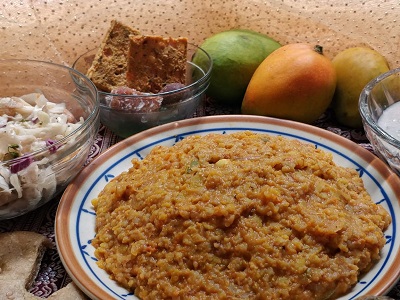
How to make Bisi Bele Bath Recipe? Learn How to Achieve an Authentic Spicy Mixed Vegetable Lentil Rice Right Away
This popular recipe has its roots in Karnataka. Known as Bisi Bele Huli Anna or simple Bele Bath, this recipe uses raw rice, pigeon pea lentils, veggies, and a unique spice powder, garnished with a sprig of curry leaves, desiccated coconut or fresh coconut to make a Spicy Mixed Vegetable Sambar Rice. Bisi means hot, bele means lentil and bath means a cooked grain dish. In villages across the state, bele bath is considered a complete meal. A spicy mixed vegetable sambar rice served with a side of crunchy potato chips ( which you can also make oil-free) can sooth your soul!
In this recipe, you will learn how to choose the healthiest, tastiest ingredients to make an authentic Karnataka style bisibelebath that your family will love.
Is it the Same as Sambar Rice? The Secret is in the Bisibelebath Powder. Don't Try Making This Delicacy Without It! Hand Make Your Own Today
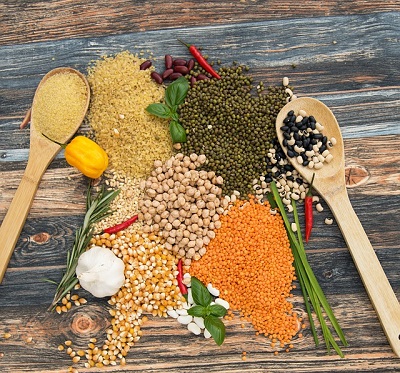
Bisi Bele Bath Masala Powder is the secret to this popular dish.
Apart from the usual sprig curry leaves and a pinch of turmeric, the spices that give flavour to this classic dish are a few pods cardamom, cinnamon & moggu. A teaspoon turmeric powder lends a bright color and plenty of phytonutrients. The original dish uses poppy seeds to lend a unique nutty flavour, and dry coconut too. However, we don't recommend using fresh or desiccated coconut dry on a regular basis, so this recipe does not feature coconut. Dessicated coconut (except defatted coconut flakes) is high in saturated fat, although it is a whole plant food. It appears to be neutral in health impact, so coconut optional. You can use coconut ½ tsp if you really wish to - we have replaced it with peanuts and other nuts in most recipes.
Some Bisi Bele Bath Video recipes ask you to heat ghee and roast spices for 2-3 minutes in it. You can make just as delicious a masala without ghee - just dry roast at low heat for 1-2 minutes until the raw aroma or raw smell leaves and a mildly roasted aroma fills your kitchen! Remember to stop roasting just before they turn light brown, just 2-3 minutes. Add 1-2 teaspoon turmeric powder after roasting, and you can your very own 4 tbsp bisi bele bath masala ready in a couple of minutes!
That's it! The trick is in the Bisi Bele Bhaat spice powder once you make the right Bisi Bele Bhat Masala. your Bisi Bele Bhath recipe can be made it suit your taste and replicated every single time. You then don't need to follow Bisi Bele Bath with step by step instructions because you've cracked the code! The first time you make it however, we recommend that you follow the entire step by step process with detailed step by step instructions.
What Brand of Bisi Bele Bath Powder to Use? Learn to Make Your Own Bisi Bele Bath Masala Recipe for the Best Taste. Never Depend on a Shop Again
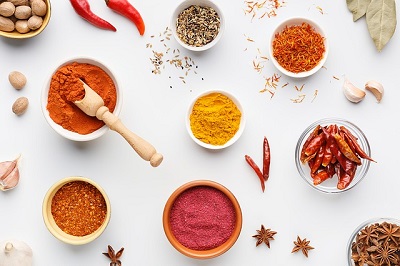
Bisi Bela Bath Spice Powder is the secret to making Authentic Bisi Bele Bath. The good news is, it simple to make your own. You can even choose the style of masala you like, the Karnataka style BisiBeleBath is among the more popular ones! Sure, you can get it at nearby shop, but I'm sure you will agree with me when I tell you nothing can compare with homemade masala for an original dish!
Once you have prepared your 4 tbsp bisi bele bath masala from the recipe below, store it in an airtight container to preserve the nice aroma. This will have a shelf life of about one month if kept on the shelf, and even longer in the fridge. You can even use bisi bele bath powder for sambar, gojju, and even cooked vegetable dishes! Make sure you bookmark this bisi bele bath powder recipe now so you can make it again when it gets over - and it will, soon!
In which state is Bisi Bele Bath famous? Discover the Ancient Roots of this Hot Lentil Rice Bath Recipe
Bisi Bele Bath was invented in Karnataka, South India. It is a simple, easy, yet nutritious and filling one pot meal, similar to sambar rice, made with rice, pigeon pea lentils, and choice of veggies, flavoured with tamarind extract and a unique bisi bele bath masala mix.
Did you know, before polished rice became commercially available,bisi bele bath rice was always handpound, unpolished rice? To add some extra oomph, you can even use brownbasmati rice! Or, choose to make Oats Bisi Bele Bath and Millet Bele Bath! The secret to all of these lies in the Bisi Bele Bath Spice Powder you make.
Vegan and Whole Food Plant Based Bisi Bele Bath Recipe That You Can Hand Make From Scratch
Bisi Bele Bath Recipe from Karnataka with Red Rice. Oil-free. Zero Ghee. 100% Vegan and Whole Food Plant Based. Ultimate indulgence. Try it to believe it!
Course: Course 3: Grain Dish for Lunch & Dinner Meals
Cuisine: Karnataka Recipe from South India
Prep Time: 20 minutes
Cook Time: 30 minutes
Servings: 4 people
INGREDIENTS
Bisi Bele Bath Recipe Ingredients
1/2 cup Red Rice / Unpolished Rice soaked
1/4 cup Toor Dal / Togri Bele (or use light pink masoor dal)
2 tbsp Peanuts
1 Potato
1 Carrot
10 French Beans
1 1/2 Regular Onions or 1 cup Pearl Onions
2 tbsp Green Peas shelled
2 Tomatoes
5 dried fruits Kokum
1 Green Chili slit
Bisi Bela Bath Spice Powder Ingredients
1 tsp Turmeric Powder
2 tsp Dhaniya / 2 tsp Coriander Seeds Powder
1 tsp Sesame Seeds / Black Til
1-2 Dry Red Chilli
1 tsp Cumin Seeds / Jeera
½ tsp Pepper Powder
2 pods Cardamom (green)
1 inch Cinnamon Stick
2 Cloves
¼ tsp Methi / ¼ tsp Fenugreek Seeds
1-2 sprig Curry Leaves
1/4 tsp Asafoetida (Asafetida / Hing ) A Pinch of Hing
Bisi Bele Bath Garnishing
4 tsp Miso Paste (Healthy Salt Alternative. See Nutrition Science Highlights below)
1 tbsp or 6-8 Cashew Nuts soaked
1 tbsp Almond Butter
1 tsp Date Syrup (Healthy Alternative for 1/2 tsp Jaggery)
1 tsp Mustard Seeds
5 Curry Leaves
2 tbsp Coriander Leaves
STEP BY STEP INSTRUCTIONS FOR BELE BATH
How to Make Bisi Bele Bath Powder Step by Step
- Dry roast methi / fenugreek seeds on low flame until just cooked. Do not allow to brown too much or burn.
- Grind all bisi bele bath powder ingredients together to a powder - 1 tsp Turmeric Powder, 2 tsp Dhaniya / 2 tsp Coriander Seeds Powder. 1 tsp Sesame Seeds / Black Til, 1-2 Dry Red Chilli, 1 tsp Cumin Seeds / Jeera, 1 tsp Black Pepper Powder, 2 Green Cardamom Pods, 1 inch Cinnamon Stick, 2 Cloves, ¼ tsp Methi / ¼ tsp Fenugreek Seeds, 1-2 sprig Curry Leaves Asafoetida. A Pinch of Asafoetida Powder would suffice. Be careful to not add more than a pinch of asafoetida (pinch of hing) the flavour will be too overwhelming otherwise in your Bisi Bele Baath Powder.
- If there is too much chilli replace with 1/2 tsp pepper powder. If it is not spicy enough for you, add some extra chilli powder.
- You can also use this spice mix for any curry recipe. Remember to add some peanut butter to make your curry creamy and spicy!
How to Make Bisi Bele Bath Recipe with Step by Step Instructions
How Much Fresh Water to Use for Bele Bath Recipe?
- Soak 1 cup unpolished red rice and toor dal with 1 tsp turmeric powder in warm water or hot water for 30 minutes. You also soak in cold water for a little longer. Wash and cook washed rice and dal with 3 cups water until it is soft and mushy. Add an extra glass of water if needed. Stir the rice container every 4-5 minutes after it starts becoming soft while cooking lentils to prevent burning. For this recipe, each rice grain need not be separate.
- Alternatively, you can use a pressure cooker to pressure cook rice and dal with 2 cups water for 4-5 whistles. Decide the pressure cooking time based on how many whistles it takes for your pressure cooker to cook rice and cook toor dal soft. Some cookers takes 3-4 whistles or less, others takes 4-5 whistles or more for toor dal. Although it has a bad reputation, you can cook healthy food in a pressure cooker. The trick is to release the pressure as soon as the 3-4 whistles or as many whistles as you need are over and not wait for natural pressure release. This shortens pressure cook time by at least 4-5 minutes, and cooks rice and dal in 20-22 minutes. This is more nutritious as pressure cook time is less then boiling in an open rice container. More details below.
How to Cook Veggies for Bele Bath Recipe in Bele Bath Curry?
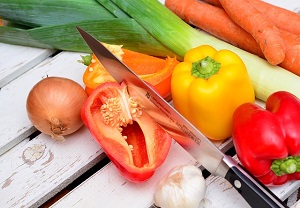
- Grind tomatoes and kokum together into a paste. Peel and chop onions into long, thin slices. Small onions or shallots are traditionally used for this bele bath recipe. Shallots have a spicier taste too! Substitute one medium sized onion with 3-4 shallots, and one large onion with 4-5 shallots.
- Chop potato, carrot, and beans into 1 inch long pieces. Peel sambar onions or peel and slice regular onions. Slit green chilli along its length. You can use your choice of vegetables. It is important to have a balance of vegetables, rice and dal.
- Cook the veggies - chopped potato, carrot, onion, beans, and peas in tomato kokum paste until cooked. Add one cup water if required to this bisi bele bath mixture. Cook until the raw aroma goes away and it becomes slightly brown in color, for around 20-30 minutes. The vegetables should be cooked just right to get a bite from veggies. You could also use green bell pepper or colored bell peppers, double beans or broad beans. Interestingly, broad beans is one of the traditional vegetables used in Karnataka. Either broad beans or fava beans, avarekaalu, is used in many sambar and bisi bele bath recipes.
- If you want to save cooking time, steam your 2 cups of vegetables separately - they get cooked in 20-22 minutes. Some vegetables like onion and capsicum can get cooked in just 7-8 minutes. Peas may take up to 8-10 minutes, potatoes at least 10-15 minutes, while beans take the longest to cook. This is the vegetable curry recipe for bisi bele bath.
- Mash cooked rice and dal, and mix into boiling veggies with 1-2 tbsp bisi bele bath powder masala. Cook for a couple of minutes until raw smell leaves. Add one cup water if required for a khichdi or porridge consistency
Additional Tempering for Bele Bath Recipe
- Heat a pan or kadai. Don't heat oil. Just heat a dry pan. When hot add mustard seeds. Keep on medium heat to prevent burning. As soon as they start sputtering, mix into bisi bele bath with cooked vegetables.
- Mix in miso paste and almond butter. This entire tempering step should take less than 3-4 minutes if you doing everything from scratch.
- Garnish the rice container with cashew nuts, and curry leaves. Top with red chillies for color! Once it cools down completely, serve fresh!
Plant Based Chef Pro Tips for Best Bisi Bele Bath Recipe
- Add more tomato paste for sourness, if needed.
- Vegetables take longer than usual to cook in tomato paste, so do plan accordingly!
- Serve bisi bisi bele bath (hot) - this amplifies the nice aroma of the delicious spices. In fact, for bisi bele bath heat is a part of the name itself - 'bisi' means hot! Perhaps we should call it Bisi Bisi Bele Bhaat
- If you visit any local Karnataka darshini or canteen, you will find hot bisi bele bath with chips. or bele bath with boondi. Serve your bele bath with potato chips - make your own chips with potatoes or banana chips raw bananas oil-free, baked in an oven and seasoned with vinegar, miso paste and nutritional yeast!
- A good bisi bele bhath powder is crucial to make this rice bath recipe delicious. The spices lend their unique aroma to this traditional Karnataka Dish, else it tastes like a regular sambar rice.
- Bisi bele bath recipe video coming up soon! Keep an eye out.
- End your meal with a nice sweet barfi. Should we make a whole food plant based recipe for barfi with step by step instructions?
Nutrition Science Highlights for WFPB Bisibele Bath Recipe
- Is pressure cooker bisi bele bath healthy? The faster something gets cooked, the more nutrition is preserved. Rice and dal get cooked fast in a pressure cooker. But if we let them sit in the cooker for longer for natural pressure release, they start losing nutrition. The trick is to release the pressure as the cooking gets over. This way, you cook the rice and dal faster than regular boiling and immediately bring it down to room temperature so that it stops losing nutrition. Pressure cooking time is a few minute less than boiling in a rice container. This may in fact be the healthiest way to cook Bisi Bele Bath! To get a similar consistency as boiling rice, use one cup of water for every 1/2 cup rice.
How to Make Bisi Bele Bath Without Tamarind Extract?
- Tamarind water is generally used to make this recipe. Here, we have used kokum instead. Kokum is a fruit from the Western Ghats, Karnataka, that is sour and can replace tamarind water easily in most recipes. Just dissolve or grind 10-15 pieces of kokum with one or two cups of water. Fresh water is sufficient to make a tamarind water mixture. You can still use 1/2 cup tamarind extract if you love the smell of tamarind - although kokum comes close! In fact, you can even use kokum to replace the same 1/2 cup tamarind extract in puliyogare, a spicy vegetable tamarind rice, or a wide variety of gojju, spicy vegetable tamarind curries. Again, fresh water is enough to make a kokum water mixture, no need to use hot water. It just takes 1-2 minutes. Try it to believe it!
- Why Miso Paste? Miso paste is fermented & salted soya bean paste. American Heart Association Maximum recommended maximum daily salt intake of 3.75 grams per person to minimise risk of high blood pressure, stomach cancer and chronic kidney disease. In addition to helping us restrict salt intake, replacing salt with miso paste also helps by neutralising the negative effects of salt by soya phytonutrients. You can easily make fresh miso paste at home by mixing 100 grams of cooked soya paste with 10 grams of salt, or 10 tablespoons of cooked soya paste with 1 tablespoon of salt. If making at home, ensure to use immediately, or freeze in batches to use later. Or, simply use 3.75 grams of salt or less per day per person and add 18 to 20 grams (dry weight) of soya beans in any dishes, spread through the day!
Is Jaggery Healthy?
- In almost any recipe bisi bele bath you will see that a jaggery mix is used. This acts as a sweetener. A lot of people think that jaggery is a healthy food, and they are right - it is healthier than white sugar and even brown sugar. However, jaggery has been to cause a spike in blood sugar levels. A healthier alternative is date syrup, which keeps your blood stable, and gives the same sweet flavour characteristic of traditional authentic Karnataka dishes. That's why, in this recipe bisi bele bath is made using date syrup. You can make your own homemade date syrup by soaking dates in a cup of water and grinding to paste in your mixie or blender in place of a jaggery mix.
- You can also mix some date sugar into bisi bele bath spice powder.
Should Rice and Dal be Soaked?
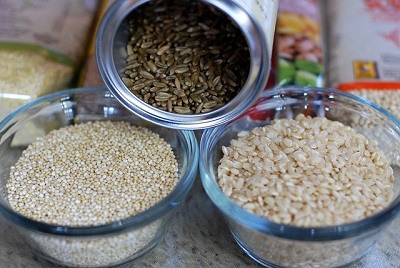
- Soaking rice and dal in warm water or hot water helps reduce cooking time, saving time and energy! Soaking for a longer time also improves the nutrient profile and releases more nutrients for easier absorption.
- If using oat groats, you can soak them for oats bisi bele bath too.
Is Bisi Bele Bath Part of a Low Calorie Diet?
- Rather than low calorie diet, we recommend aiming for a low calorie density diet. This way, you can eat more, weigh less, without the need for portion control or calorie restriction! There are three ways by which bisi bele bhaat helps achieve a low calorie density diet. One is the vegetables and lentils that used along with rice. Second is that we use whole grains, and third is a neat trick of cooling down bisi bele bhaat (you can always heat it again before serving). Here's how these help.
- Why whole grains? Whole grains are healthier than refined grains such as white rice, refined flours, maida, rava, etc., as the bran layer is intact, with all its vitamins, minerals, and phytonutrients. Whole grains have been found to be protective against a whole range of chronic diseases, including heart disease, diabetes, and lifestyle-related cancers. Choose brown rice, red rice or black rice grain instead of white rice.
- Why cool grains? When cooked grains are allowed to cool on the counter or in the fridge, its starch crystallises to form resistant starch. This can be eaten by our good gut bacteria and also reduces the glycemic index (the rate at which glucose is absorbed), making the whole grain even healthier. For the same reason, parboiled whole grains can be used as well.
How to Roast Onion and Peanuts?
- What's wrong with roasting? The brown color we get on roasting whole grains, tubers, legumes, or nuts is due to the formation of carcinogenic AGE compounds. We can reduce the formation of these compounds by roasting peanuts mildly, on a low flame.
- Spice powders like bisibelebath powder can be mixed into the vegetables while boiling them, towards the end. Remember to reduce to medium heat at this point.
- Many recipes also call for a drizzle of ghee - additional ghee added in after cooking. This doze of ghee can be replaced with an equal about almond butter - 1 tbsp of ghee can be replaced with 1 tbsp of almond butter. It gives an amazingly rich flavour just like butter ghee.
- Your usual approach may be to heat oil in a pan and once hot add onion. You may also roast it until you achieve a deep color. Did you know you can achieve the same results by roasting onions with a little bit of water or vinegar. Just heat a pan with a little bit of water or vinegar and once hot add onion. Keep stirring until you get a mild roasted aroma. Also stop roasting before it turns to a deep color for healthiest results.
Is Ghee Healthy?
- Ghee is a concentrated source of cholesterol and saturated fat. It has been associated with a higher risk of chronic diseases such as atherosclerosis and heart disease. Even 1 tsp ghee or 1 tbsp of ghee eaten regularly can add up in the long run.
How to Make Oil-free Tempering with Curry Leaves and Chilli for Bisibele Bath? How to Roast Spices Without Oil and Ghee
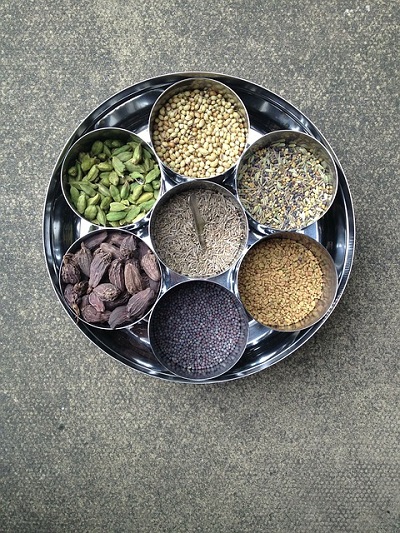
- Why not tadka? Tadka, thaaLippu, oggaraNe. After cooking, additional tempering spices in oil is quintessential to Indian cuisine. Oil for tempering may have started as a compromise when whole nuts were unavailable, and indeed, is more common in inland, drier areas where nuts do not grow easily, all year round. You can enjoy the taste and fragrance, without using any oil for tempering, by just dry roasting the spices you require, without the oil, or even better, mixing spice powders directly into your dish!
- While roasting, most recipes call for adding 1 tbsp ghee or oil and then roasting to a light brown or golden brown color. However, that tablespoon ghee may increase your risk of high cholesterol and heart disease when consumed on a regular basis - even a few times a week. So, whether it is cumin seeds, two tablespoons coriander seeds, or 2 tsp urad, heat a kadai to medium heat and once hot add mustard and other spices one by one - without one tsp ghee or tbsp oil - to get all the flavour with none of the disease risk.
